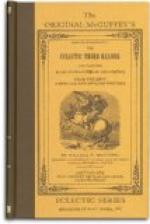3. The gentleman took the dollar, and asked George if he had no more money. George said he had not. “Well,” said he, “this will do.”
[Illustration: George paying for broken window.]
4. So, after asking George his name, and where he lived, he called him an honest boy, and shut the door.
5. George went home at dinner time, with a face as rosy, and eyes as bright, as if nothing had gone wrong. At dinner, Mr. Ellet asked him what he had bought with his money.
6. George very honestly told him all about the broken window, and said he felt very well without any money to spend.
7. When dinner was over, Mr. Ellet told George to go and look in his cap. He did so, and found two silver dollars there.
8. The man, whose window had been broken, had been there, and told Mr. Ellet about it. He gave back George’s dollar and another besides.
9. A short time after this, the man came and told Mr. Ellet that he wanted a good boy to stay in his store.
10. As soon as George left school, he went to live with this man, who was a rich merchant. In a few years he became the merchant’s partner.
LESSON LXII.
line fig’ure sec’ond grain verse per’fect ly
ad vice’ im pa’tient stud’y bus’i ly fol’lowed un der stand’
[Illustration: Mother talking to small boy. Hour-glass and flowers on table between them.]
FRANK AND THE HOURGLASS.
1. Frank was a very talkative little boy. He never saw a new thing without asking a great many questions about it.
2. His mother was very patient and kind. When it was proper to answer his questions, she would do so.
3. Sometimes she would say, “You are not old enough to understand that, my son. When you are ten years old, you may ask me about it, and I will tell you.”
4. When his mother said this, he never teased any more. He knew she always liked to answer him when he asked proper questions.
5. The first time Frank saw an hourglass, he was very much amused; but he did not know what it was.
6. His mother said, “An hourglass is made in the shape of the figure 8. The sand is put in at one end, and runs through a small hole in the middle. As much sand is put into the glass as will run through in an hour.”
7. Frank watched the little stream of sand. He was impatient, because it would not run faster. “Let me shake it, mother,” said he; “it is lazy, and will never get through.”
8. “Oh yes, it will, my son,” said his mother, “The sand moves by little and little, but it moves all the time. 9. “When you look at the hands of the clock, you think they go very slowly, and so they do; but they never stop.
10, “While you are at play the sand is running, grain by grain, The hands of the clock are moving, second by second.




